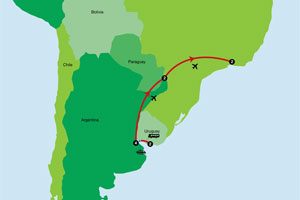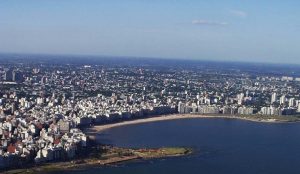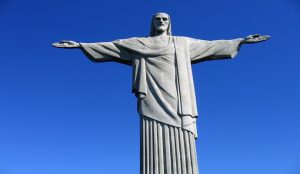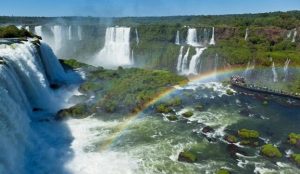 Print Itinerary
Print Itinerary
Taste of South America is a route developed for travellers with a bit more time to discover the secrets of South America, visit Uruguay and its untouched sandy beaches; Argentina and its cosmopolitan cities; Brazil and its rythims. This is an itinerary to introduce you to South America!
- Airport / Hotel Transfers
- Accommodation with daily breakfasts
- Guided tours as per itinerary
- Visits to some of the main attractions in Uruguay, Argentina and Brazil, including entrance fees
- And much more…
Day 1 MONTEVIDEO
Upon arrival in transfer from the airport to the hotel.
Day 2 MONTEVIDEO (B)
Today we will depart for a 3 hour city tour through Montevideo. The main points of interest are the Old City, Contitution Square with Cathedral and Colonial Town Gall, Solis Theatre, Independence Square at the centre of which stands a monument dedicated to the national hero, Jose Gervasio Artigas and his Mausoleum. Facing the square is the Government House (museum of the Presidents). The main commercial street 18 de Julio is lined with shops, cafes and office building. The huge Congress Building is the pride of Uruguay. It was constructed between 1908 and 1925 with local marble of 52 colors and 12 types of wood. Drive past the Prado neighbourhood, one of the oldest parks in the city which hosts the famous sculpture La Diligencia (The Stage Coach), Monument to the last Charruas Indians, the Rose Garden where you will be able to spend some minutes around the Prado Hotel. Continue onto Battle & Ordonez Park, passing by the Obelisk, La Carreta (Covered Wagon) monument and the Soccer Stadium. Then we will stop at Plaza Virgilio with the monument dedicated to the Fallen Soldiers of the Navy and from which an excellent view of the city will offer a great spot for photographers.
Day 3 MONTEVIDEO – COLONIA – BUENOS AIRES (B)
Transfer from your hotel to the bus terminal. You will board a very comfortable regular bus with air-conditioning to Colonia del Sacramento (without guide). The journey to Colonia del Sacramento will take approximately 2 hours.
Upon arrival your tour guide will pick you up at the bus terminal and you will enjoy a comprehensive city tour. Colonia del Sacramento is a small colonial city founded by the Portuguese in 1680, at a time when Spain and Portugal were in the midst of confrontations. For over a hundred years both empires fought over it, until finally the Treaty of Saint Ildefonso awarded it to Spain.
Today the Old City has a lot to say about its Colonial past. Visit the picturesque streets of Colonia del Sacramento, the oldest city in the country, recently declared a World Heritage site by UNESCO. The streets of Santa Rita, San Gabriel, the Matriz Church, San Pedro road, the Bastion del Carmen, the famous “ Calle de los Suspiros “ (Street of Sighs) used so often as scenery for historical films, Puerta del Campo, Plaza Mayor 25 de Mayo. The past can still be felt, in the city’s cobblestone streets and stone walls. Colonia complements its archaeological values with natural beauty, the permanent company of the Uruguay River and the emblematic monuments that stand out on the horizon, such as the cathedral and the lighthouse, and very close by, the Real de San Carlos bullring.
The city tour ends at the ferry station where you will board the Buquebus to Buenos Aires (approx 1 hour). Upon arrival in Buenos Aires transfer from the pier to the hotel.
Day 4 BUENOS AIRES (B)
In the afternoon you will visit the most important sites during a city tour. You will drive to the Plaza de Mayo, with the Casa Rosada, the pink house, seat of the government, the Cabildo (town hall) and the Metropolitan Cathedral, home of the Archbishop of Buenos Aires. The tour goes onto the district of San Telmo. Until 1888 this part of the city was a river port, today San Telmo is one of the most modern and desired places to live in Buenos Aires.
The worker district La Boca is famous for its colourful tin-houses and its history as the living district of Italian seamen and dock workers in the 19th century. The Barrio Norte called Recoleta is the quarter of the rich of Buenos Aires. On the cemetery of Recoleta one will find the grave of Eva Duarte who became famous as Evita Perón. Continue along the widest avenue in the world, the Avenida 9 de Julio, to the Plaza Lavalle with the Federal Court of Justice and the Teatro Colón, to Palermo with its parks and gardens. Return to the hotel.
Day 5 BUENOS AIRES (B)
Day at leisure – the following optional tours can be booked with our office:
Optional: Full day visit of a typical Estancia incl. lunch and short visit of San Telmo – Enjoy a complete day out in the pampas! First we visit the famous Sunday flea market of San Telmo for a short walk around the main plaza. Then we leave the city and after a 2 hour drive to Los Cordales we will reach the Estancia Santa Susana, where the guests will be welcomed by Gauchos along with a drink. There is time to visit the Estancia and the daily life of the Gauchos will be explained. Sulky and horse rides will show you the charm of Argentine countryside, its scenarios, and the incomparable wild aroma.
Then follows a rustic Barbecue (Asado) lunch with fine meat and sausages. After lunch, a folklore show will present regional music and dances. During the Fiesta Gaucha guests will experience these men’s agility with their horses on the Estancia. After the afternoon coffee and tea time you will return to Buenos Aires.
Optional: Visit to the San Telmo market. San Telmo is no doubt the best kept historical neighbourhood and oldest district of Buenos Aires. Here one has time to stroll around Plaza Dorrego, where each Sunday an antique market takes place. Tango couples are dancing on the street. Cafes invite to sit on their terrace and to relax by enjoying this nice scenery. Another attraction are the numerous antique shops, where one might find the right souvenir.
Day 6 BUENOS AIRES (B)
Today you will enjoy a half day Tigre Tour. Drive along the northern residential districts of the city, until arriving at San Isidro, a colonial and aristocratic area. You will see the mansions and houses in front of the River Plate. You will continue the driving to Tigre, a charming area near Buenos Aires city where a great number of summer residences, yacht clubs and rowing clubs attract the weekend activity of many “porteños”.
The Tigre Delta with its rivers, streams and numerous green islands is one of the most attractive areas for visitors. The continuous sediment of the Paraná River, which gives the river and estuary their particular brownish-red colour, forms the Delta islands. Enjoy a boat excursion (1 hour) along the innumerable channels of the Paraná-Delta to see some of the hundreds of islands covered with luxuriant vegetation.Drive back to the city via the Panamericana Highway.
Day 7 BUENOS AIRES – IGUASSU (B)
Transfer to the airport for the flight to Iguassu (flight is not included).
Upon arrival in Iguassu pick-up at the airport and transfer to the Argentinean National Park towards the Argentinean side of the falls. You will make a short stop at the Visitor’s Centre and proceed from there along the Inferior Circuit, the down-river falls, to the Superior Circuit, the up-river cascades. The Ecological Jungle Train leads you to the most impressive observation point of the falls – The Devil´s Throat. After visit transfer to the hotel on the Brazilian side of the falls.
Day 8 IGUASSU (B)
In the morning visit the Brazilian side of the falls. Walk along the paths following cascades and then along the catwalk that leads very close to the bottom of the Devil’s Throat to enjoy magnificent views. Take an elevator to go up to the road in order to board the coach which will bring you back to the hotel.
Day 9 IGUASSU – RIO DE JANEIRO (B)
Transfer from the hotel to the airport for the flight to Rio de Janeiro (Flight is not included).
Arrival in Rio and transfer to the hotel.
Day 10 RIO DE JANEIRO (B)
Leave the hotel and proceed as far as Cosme Velho Station to board a cog-train(*) for the ride through Tijuca Forest up Corcovado Mountain at 748 m (2.454 ft) high. The train ride takes 20 minutes and is a wonderful opportunity to have a closer look at the forest’s lush tropical vegetation and to enjoy scenic landscapes of the beaches and city. Disembarking at the top of Corcovado and then proceeding up the steps that lead to the top lookout where the towering statue of Christ the Redeemer stands.
After appreciating the breathtaking view unfolding below, passengers will descend by train. The tour proceeds passing by Rio’s world-famous beaches as far as Urca District to board a cable car for a two-staged ascent up Sugar Loaf Mountain at 390 m (1.280 ft) high. Then coming down and proceeding along Guanabara Bay and Flamengo Park as far as downtown. Visit downtown area, passing by the financial and business centre and by other attractions such as the Candelaria Church, Saint Sebastian Cathedral, Lapa Arches, Municipal Theatre, National Library, Fine Arts Museum, and by the Sambadrome, site of Rio’s famous Carnival parade.
*Note: or Vans certificated by the city´s administration departure from Largo do Machado where the van stop is located and go to top of Corcovado.
Day 11 RIO DE JANEIRO (B)
Transfer to the airport and return flight home.
End of our Services
Food Code = (B) – Breakfast, (L) – Lunch, (D) – Dinner.
LHSTMVD001 *Please note, prices based on twin share, per person, low season, 3 star rates. Optional tours not included and are at extra cost. The itinerary & pricing can change at any time due to availability of activities. Please check our website for full terms and conditions*
More information about the visited countries
Uruguay – is one of South America’s best kept secrets! Counting 600 km of coastline with beautiful untouched sandy beaches as well as stunning landscapes in the interior of the country along with Spanish, Portuguese, Italian and British influences make Uruguay a small country with a lot to offer. While the people in the larger cities on the coast of the River Plate mostly live a modern life style you can still find real “gauchos”, the South American “cowboys”, leading a more traditional country life in the interior of Uruguay. Uruguayans are a kind and welcoming people with a great love for “mate”, a traditional South American caffeine-rich infused drink, “asado” (BBQ), carnival and of course football. When you first arrive in Uruguay you will be surprised to see people walking in the streets or waiting for the bus with their “mate” in their hand and thermos flask tightly tucked under their arm.
Argentina – the second largest state in South America, has a surface of 2.8 million square kilometres. The country has 33 million inhabitants and nearly half of them live in the surroundings of Buenos Aires, one of the most cosmopolitan cities of the world. Argentina is a fascinating land of contrasts where the exceptional is almost commonplace. It’s home to an abundant wildlife, enjoys a unique culture, and delights in an astonishing variety of landscapes from tropical rain forest in the north to the remote vastness of the Antarctic in the South. Three big landscapes form the country: the Andes in the west, the northern and western flatland as well as the wide plains of Patagonia in the south. The country that is stretched in length has three climatic zones: tropic in the north, moderate in the centre and polar in the extreme south. The native Indian people live in the north-western Andean region and in the north-east province of Misiones. The rest of the population is mainly composed of European immigrants. The official language is Spanish, but in larger towns English is also quite common.
Brazil – with this term one associates endless Amazon jungle, wonderful beaches, Rio de Janeiro, carnival and samba. This is all correct but in reality, Brazil is much more, a huge country of the superlatives. Brazil, a country of immense proportions and contrasts, has a mysterious attraction for many people. With a surface of 8.5 million km², Brazil is approximately as big as Europe and covers half of the South American continent. The climate changes from the permanent warm, tropic north over all sub tropic variants to the moderate south. Since the 16th century – when the Portuguese began to settle in the country – Brazil has always had a magic attraction to foreigners. First there was the gold and then rubber and coffee and today it is above all the rhythm and the exotic that attracts tourists. People over there show a lot of happiness, kindness and spontaneity. The largest country in South America is a mirror of fascinating pictures.
More information about the visited cities:
Montevideo – the Capital of Uruguay is a beautiful city with old buildings of Spaniard, French and Italian style architecture, mostly very well preserved and also modern construction surrounded by parks and the river.
Colonia del Sacramento – is a small colonial city founded by the Portuguese in 1680, at a time when Spain and Portugal were in the midst of confrontations. For over a hundred years both empires fought over it, until finally the Treaty of Saint Ildefonso awarded it to Spain. Today the Old City has a lot to say about its Colonial past.
Buenos Aires – is not only the capital of Argentina; it is also one of the 10 most important metropolises in the world and the centre of the political, economic and intellectual life of the country. This cosmopolitan city – with great European cultural influence – displays a refined taste in its cooking, in its ”boutiques” and in the elegance of its inhabitants. Almost 12 million people live there and can enjoy the plentiful night life visiting ”tango” bars, cabarets, discotheques, restaurants or eternally open bars. During the day, a wide variety of attractions is offered: museums, art galleries, tasteful shops, fascinating antiques, large green areas, parks, wide tree lined boulevards, clubs and sporting events. The Italian-Spanish descent of the inhabitants has formed this modern metropolis. Feel the flair, above all in the Italian old quarter La Boca and in the wide streets with cafes from the turn of the century. At the Plaza de Mayo, in the political centre of town, is the starting point of this tour through this exciting capital. The widest street of the world, the very famous opera house and also the shopping street Florida make Buenos Aires unforgettable.
Iguassu – one of the biggest wonders of nature in South America: located amidst a sub-tropical forest in the triangle of Argentina, Paraguay and Brazil, a gigantic row of waterfalls flows down into the river Iguassu.
Rio de Janeiro – founded in 1556, the city of St. Sebastian of Rio de Janeiro became the capital of the Colony of Brazil in 1776. In 1808 the Portuguese royal family fled Napoleon and settled in Rio. This brought a surge of progress and the city became the main cultural, political and economic centre of the Portuguese empire. In 1889, when the republic was proclaimed, Rio was confirmed as the country’s capital, which it remained until 1960, when the construction of the new capital, Brasilia, was founded. Rio is situated in a 15-mile-strip of land, wedged between mountains and sea. There are some thirty miles separating downtown Flamengo, from far-flung Recreio, bordered on one side by the blue sea, on the other by verdant hills. Between them lies a colourful state of mind called CARIOCA, with almost 8 million locals who samba their way through life, relaxed and high-spirited. That is just the way it should be in Rio, surrounded by natural beauty on all sides, with Christ the Redeemer perched on top of Corcovado blessing the city and Sugar Loaf, one of the most famous postcards of our country.
More information on visa requirements
Uruguay: Australian citizens are not required to hold a visa when staying for a maximum period of up to 90 days in Uruguay.
For more information contact your nearest Uruguayan embassy/consulate.
Argentina: Australians are required to pay a reciprocity fee of about USD 100.00 when travelling to Argentina. The reciprocity fee must be paid online before the start of the travel.
Brazil: Australians are required to pre-arrange a visa. Visa normally will give you the right to spend 90 days in the country.
For more information: http://camberra.itamaraty.gov.br/en-us/tourist_visa.xml






